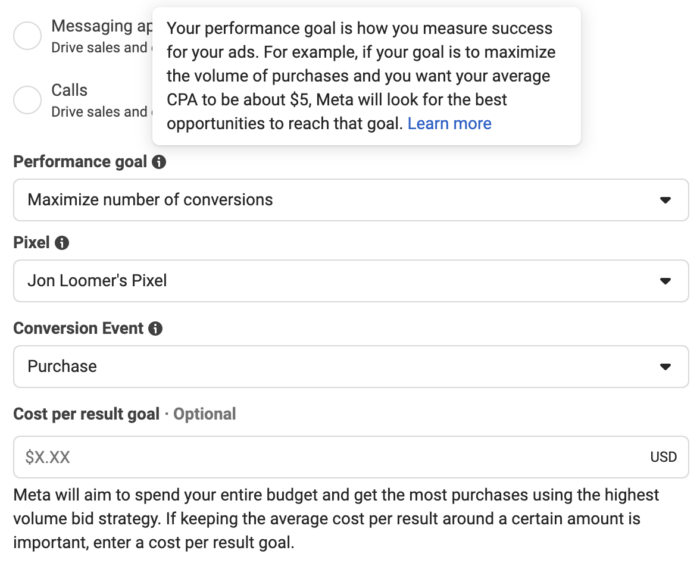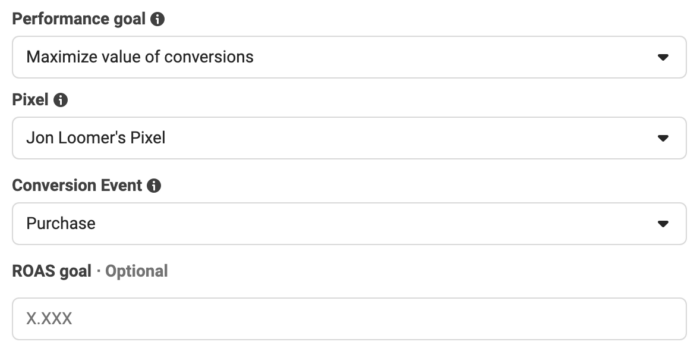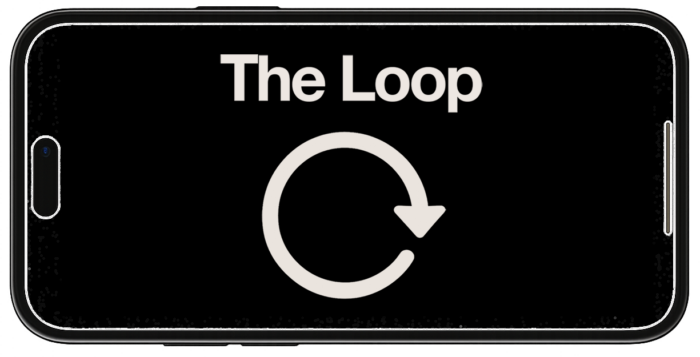The Meta ads algorithm is powerful. It learns, tweaks, and optimizes in real-time to get you the most results as efficiently as possible. But it’s critical that you understand how Meta ads optimization for delivery works.
If you go into this blindly, you will be misled by results. You will get results that seem too good to be true (because they are). You will be frustrated. And you may even give up on Meta advertising because of it.
But once you understand exactly how Meta ads optimization works, you’ll have a better sense of its strengths and weaknesses. You will be better equipped to mitigate those weaknesses to leverage what makes it so powerful.
This is an important post. Let’s go…
How Optimization Works
The first and most important step of Meta ads optimization is selecting a performance goal in the ad set.

Advertisers often misunderstand that the campaign objective determines optimization. The objective’s only impact is on the options available when selecting your performance goal.
In the example above, Maximum Number of Conversions is selected. Meta will search for the best opportunities to achieve that goal.
In this case, the advertiser also defines the conversion event they want to prioritize. Here, it’s a purchase.
Finally, since we’re using the Highest Volume bid strategy (which is selected by default), Meta will attempt to generate the most conversions (purchases in this case) while spending our entire budget.
To understand how Meta ads optimization for delivery works, you must understand the contribution of these things. Meta’s entire focus is on getting you the results that you want. You tell Meta what you want with these settings.
Meta will adjust delivery in real-time to attempt to accomplish these goals. The people you reach, the placements your ads are shown, and the formats and ads that are displayed are all evolving as Meta learns from the results. This delivery is driven entirely by your performance goal.
To drill this home further, the ways Meta optimizes will be different depending on whether you’re optimizing for purchases, link clicks, ThruPlays, leads, or something else. You could provide the same targeting, placements, and ads in each case, but Meta will deliver your ads differently to make sure you get the actions you want.
Weaknesses
The strengths and weaknesses of Meta ads optimization are closely tied together. What makes it powerful can also be problematic in certain circumstances.
Understand that the ads delivery algorithm is literal. If you tell Meta that you have a certain performance goal, the algorithm will do everything it can to get you the thing that you want. Nothing else will matter (later, you’ll see why this can be an issue).
This can especially be an issue for top-of-the-funnel actions. But truthfully, it applies to almost every performance goal (minus a couple of exceptions we’ll get to later).
In order to satisfy your goals, Meta will be focused on volume and costs. The algorithm will exploit the cheapest ways to get you these actions.
Weakness #1: Countries.
Let’s assume you’ve selected 20 different countries in your targeting. The costs to reach people in these countries vary considerably. If you optimize for link clicks, landing page views, or even leads, you can expect that the vast majority (if not all) of those actions will come from the cheapest countries. Why? That’s the best way to generate the most volume for you.
Weakness #2: Placements.
Audience Network is a placement that’s notorious for accidental clicks and even click fraud. You can bet that any refund you receive from Meta for advertising is related to the discovery of click fraud on this placement. But that won’t prevent the algorithm from loading you up with clicks if that’s your performance goal. There are other weaknesses related to ThruPlay and users who are forced or incentivized to watch videos.
Weakness #3: Erratic behavior.
I don’t want to call this abnormal or even questionable. The truth is that some people are likely to click on just about anything. Some people can’t help but comment on or like everything. Some people need to fill out every form. These may be low-quality actions, but that doesn’t matter. If you tell Meta you want that action, these are the first people you’ll reach.
Weakness #4: Attribution setting.
Conversions are mostly safe, but be careful with light-touch conversions (searches, content views, custom events) that utilize the 1-day view attribution setting. It’s not that view-through conversions are bad. They just aren’t as valuable as click-through conversions. And if Meta knows that you can get a lot of the action you want by simply showing ads to people who likely would have gone to your website anyway, that is going to happen.
Always think about the ways that your results can be inflated based on your performance goal. All of these examples can lead to low-quality results.
Organic and Ad-Driven Behavior
The weaknesses of optimization are weaknesses for one simple reason: Organic and ad-driven actions are not the same thing. We should not expect both groups to act the same way.
For example, you may have a 5% conversion rate to a certain landing page from organic traffic. Of the 100 people who visit there, five will buy from you.
You may assume that if you optimize for link clicks or landing page views, you can send 100 people to that page with an ad and maintain that 5% conversion rate. You will not. In fact, you probably won’t get any purchases.
Advertisers are often tempted to optimize for top-of-the-funnel actions because they assume that these actions have greater meaning than they actually do. They assume that if someone clicks your link, they’re as likely as the typical user to convert. They assume that if someone watches a video, they are actually interested in what they are watching.
You must remember a simple fact: When Meta optimizes the delivery of your ads, the only concern is generating the action you have prioritized (your performance goal). The algorithm does not care whether these people do anything else beyond that one action.
You, of course, do care.
Strengths
Up until now, this post seems like an indictment of Meta ads optimization. It’s not. It could be better, but it’s actually incredibly powerful.
It’s especially useful when the algorithm can’t be distracted by cheap actions. The best example: Purchases.
For all of the same reasons that it can be problematic that Meta does all it can to generate cheap actions for the top-of-the-funnel, it’s powerful when optimizing for a purchase. Meta’s singular goal is to get you as many purchases as possible within your budget.
Placements can’t be exploited for accidental purchases (unlike accidental clicks). Meta can’t go after low-quality purchases (unlike low-quality leads). And if you want to generate a higher ROAS, you can even optimize for Value so that the algorithm focuses on people who will spend the most money on your website.

If a placement isn’t resulting in purchases, the algorithm adjusts. If people aren’t buying after clicking on one of the ads, the algorithm is tweaked. If people in a country are clicking but not buying while people in another country do, the algorithm will move your budget.
Meta has all the data in the world to tweak and optimize in real-time to place your ads efficiently and give you the best opportunities to get the most of the action that you want. If you want purchases, the algorithm won’t mislead you.
How to Mitigate Weaknesses
Once you understand the weaknesses of optimization, you can do your best to mitigate many of them and limit the damage. Here are a few steps that you can take:
1. Optimize for the action you want.
Don’t assume that one action will lead to the next. There are times when you can’t optimize for a purchase because of volume issues. Otherwise, don’t get cute. Go straight for your desired action.
2. Avoid top-of-the-funnel optimization if you can.
This especially relates to link clicks and landing page views. Optimize for something better if you can. Remember, the actual click or landing page view has very little value. They might all abandon your website immediately. Instead of simply driving clicks, optimize for a certain action you want them to take when they get there (this is one way that I use custom events).
3. Approach countries carefully.
This is especially important if you’re not optimizing for a purchase. All of your clicks, engagement, and leads will come from the cheapest countries, and people from these countries may be less likely to buy. Consider grouping similar countries and removing some entirely.
4. Adjust placements depending on optimization.
When optimizing for a conversion, you should be safe using Advantage+ Placements. But, remove Audience Network when optimizing for link clicks or landing page views (accidental clicks and click fraud). Remove Audience Network Rewarded Video when optimizing for ThruPlay (incentivized views). And consider only using the most impactful placements when optimizing for Reach (otherwise, the algorithm will focus on the cheapest impressions).
5. Adjust the attribution setting where necessary.
I have no issues with view-through attribution generally. It’s important to understand when conversions are view-through. You should prefer a higher percentage of click-through conversions. Beyond that, the main thing is to make sure that the algorithm doesn’t inflate results with view-through conversions when they are likely for light-touch conversions. Change the attribution setting to 7-day or 1-day click in this case.

An example is if you optimize for custom events, like I do, for an action like a 1-minute page view. This is something that is bound to happen over and over, especially for loyal visitors. If 1-day view is an option, the algorithm could inflate the numbers by simply displaying ads to people who are likely to visit my website that day anyway. While displaying ads to loyal visitors for most conversions would be preferred, this would lead to a gross misrepresentation of results.
What Meta Could Do
There’s a separate philosophical discussion about what Meta could or should do to prevent many of these issues. Top-of-the-funnel optimization is problematic, but it doesn’t have to be.
A couple of things Meta could do:
1. Provide more options for quality optimization.
I don’t just want link clicks, I want people who spend more time on my website and are bound to return. I don’t just want people who watch my videos for 15 seconds, I want people who willingly (without incentive or being forced) watch 75% of it and may watch them again.
There’s no reason why Meta can’t provide an option to optimize for higher-quality actions, knowing that the costs could go up. It’s a trade-off advertisers would gladly take.
2. Provide a secondary performance goal.
This is something I’ve thought of lately. We can optimize for link clicks, landing page views, or add-to-cart. We don’t optimize for that action just to get as many of those actions as possible. We expect them to do something else as well.
What if advertisers could provide a secondary performance goal as a quality check? You can’t optimize for purchases because you don’t get enough volume to exit learning. But it could be the way that Meta decides whether the add to cart optimization is working.
There are surely other steps Meta could take as well. Truthfully, they’re unlikely to happen. Meta’s focus is primarily on e-commerce, which is what makes them the most money.
Watch Video
I recorded a video about the issues with optimization, too…
Your Turn
How do you approach Meta ads optimization?
Let me know in the comments below!







